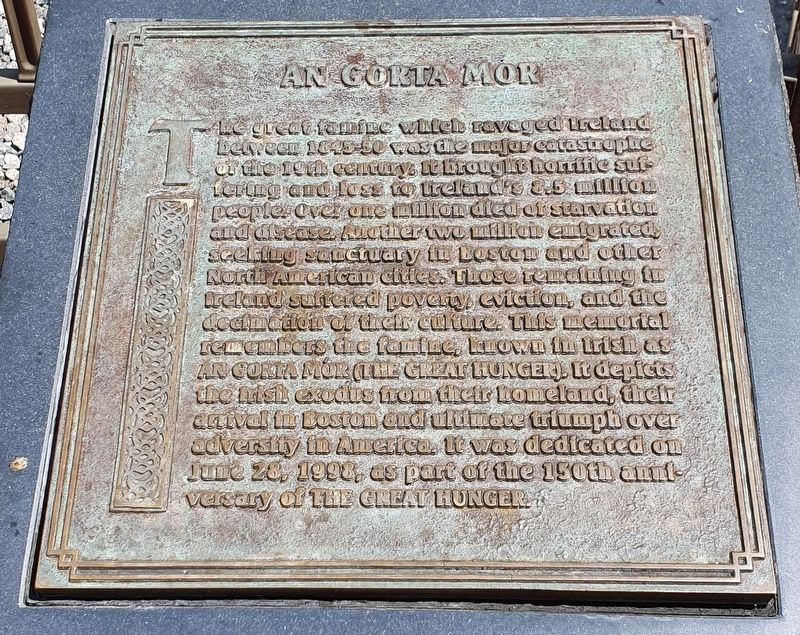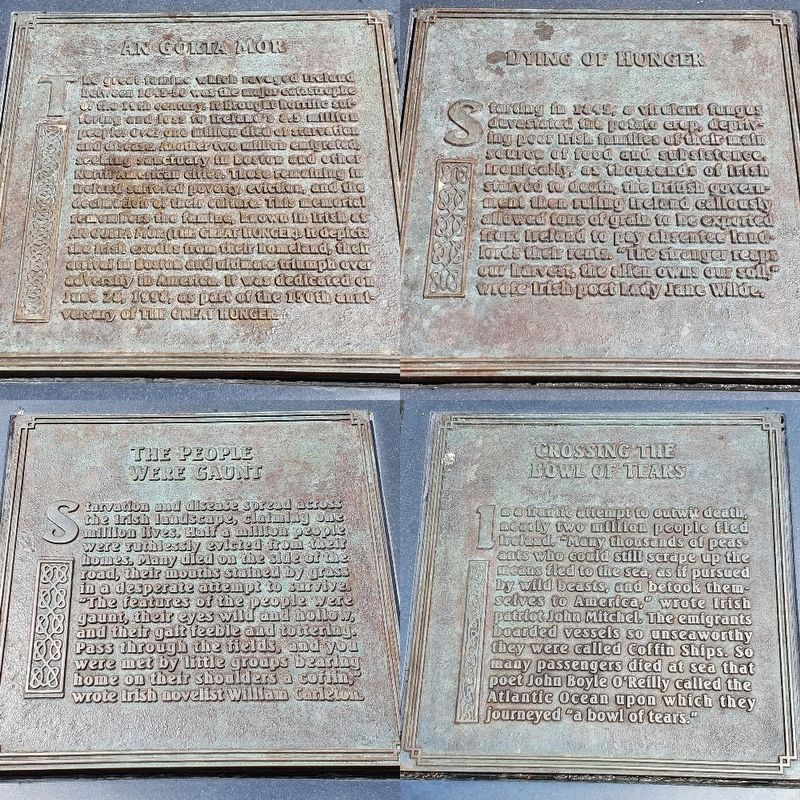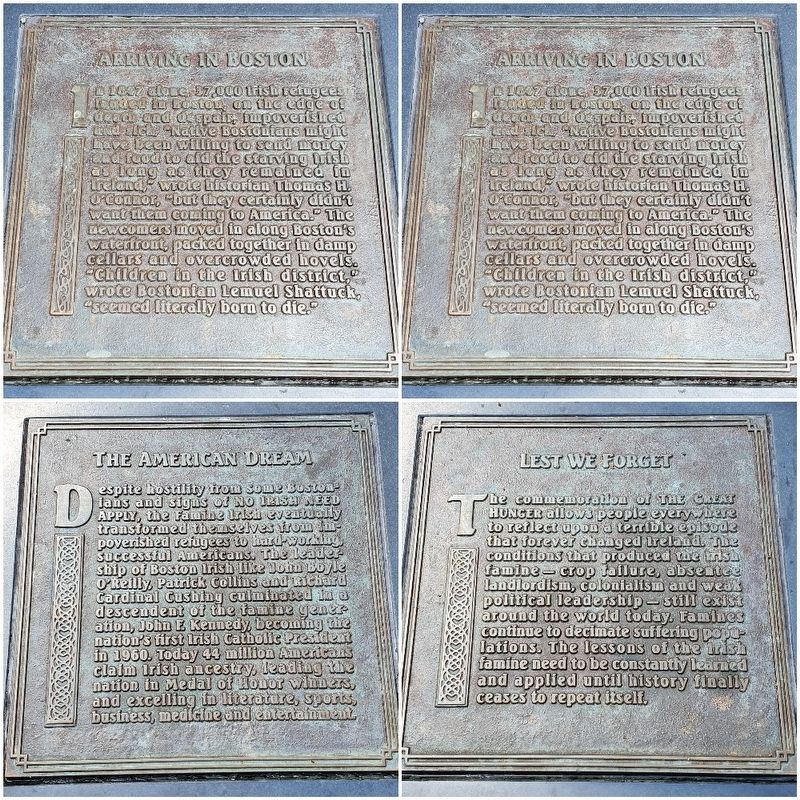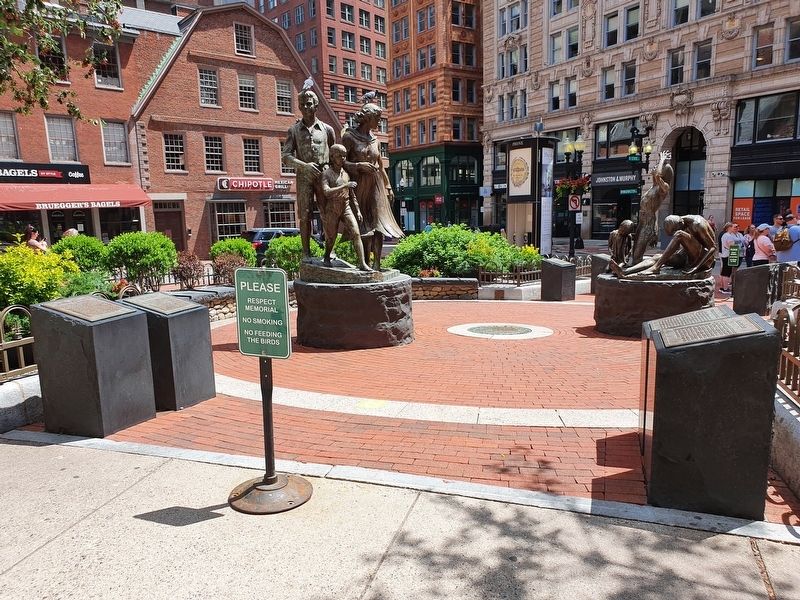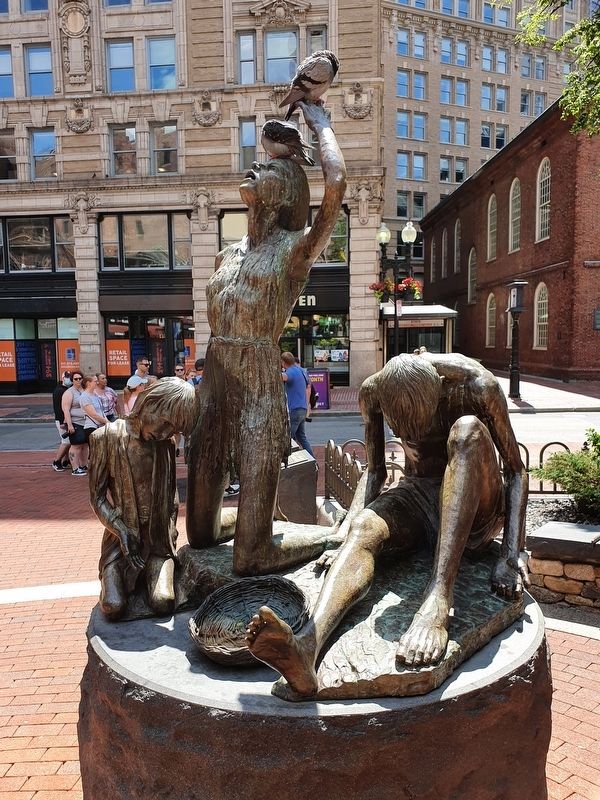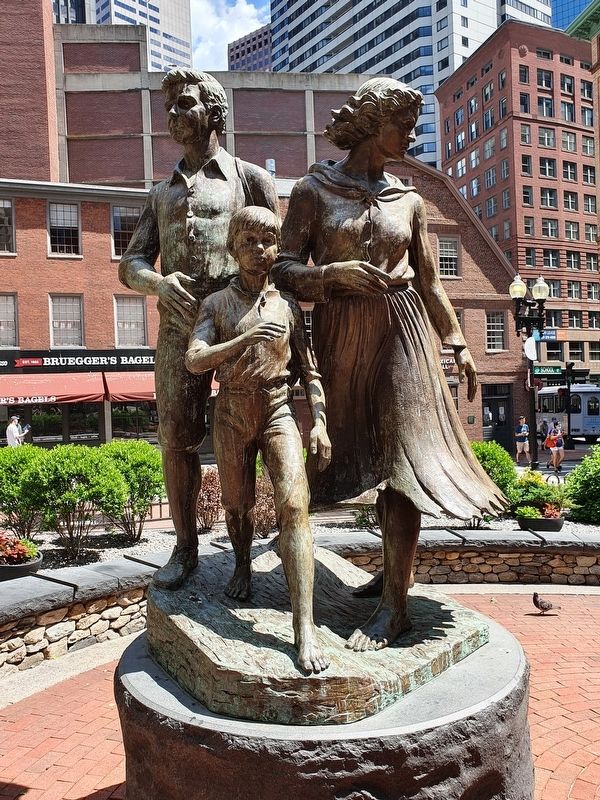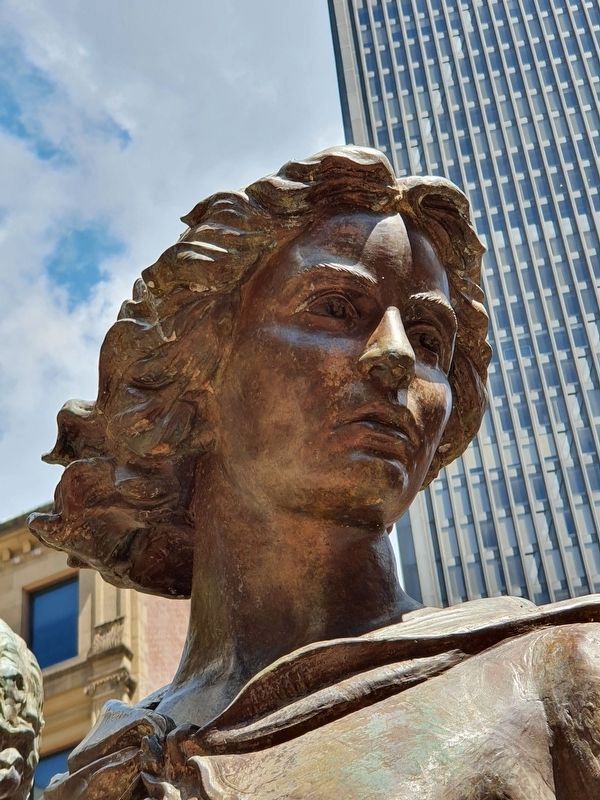Downtown Crossing in Boston in Suffolk County, Massachusetts — The American Northeast (New England)
Boston Irish Famine Memorial
An Gorta Mor
The great famine which ravaged Ireland between 1845-50 was the major catastrophe of the 19th century. It brought horrific suffering and loss to Ireland’s 8.5 million people. Over one million died of starvation and disease. Another two million emigrated, seeking sanctuary in Boston and other North American cities. Those remaining in Ireland suffered poverty, eviction, and the decimation of their culture. This memorial remembers the famine, known in Irish as An Gorta Mór (The Great Hunger). It depicts the Irish exodus from their homeland, their arrival in Boston and ultimate triumph over adversity in America. It was dedicated on June 28, 1998, as part of the 150th anniversary of The Great Hunger.
Side of monument
Irish Famine Memorial
To commemorate the tragedy of An Gorta Mór and the triumph of those immigrants who came to Boston
Dedicated June 28 1998
Thomas J. Flatley Chairman
Thomas M. Menino Mayor of Boston
A. Paul Cellucci Governor of Massachusetts
Seamus Brennan T. D. Minister of State Government of Ireland
H.E. Sean O’Huiginn Ambassador of Ireland to the United States
Thomas O’Brien Boston Redevelopment Authority
Dying of Hunger
Starting in 1845, a virulent fungus devastated the potato crop, depriving poor Irish families of their main source of food and subsistence. Ironically, as thousands of Irish starved to death, the British government then ruling Ireland callously allowed tons of grain to be exported from Ireland to pay absentee landlords their rents. “The stranger reaps our harvest, the alien owns our soil,” wrote Irish poet lady Jane Wilde.
Partners
BankBoston / The Boston Globe / The Edward Ingersoll Browne Fund / Jim & Barbara Cleary / Mr. & Mrs. William F. Connell & Family / Joe & Rose Corcoran / Tom & Charlotte Flatley & Family / Fleet Bank / Mr. & Mrs. John A. Kaneb / Carolyn & Peter Lynch / Bud & Eileen Roche / The Sheridan Foundation / The Yawkey Family
The American Ireland Fund / The Ancient Order of Hibernians / Boston College / The Charitable Irish Society, Est. 1737 / The Eire Society / Gaelic athletic Association / The Irish American Partnership / The Irish Cultural Centre / National University of Ireland, Galway / Stonehill College
The People Were Gaunt
Starvation and disease spread across the Irish landscape, claiming one million lives. Half a million people were ruthlessly evicted from their homes. Many died on the side of the road, their mouths stained by grass in a desperate attempt to survive. “The features of the people were gaunt, their eyes wild and hollow, and their gait feeble and tottering. Pass through
the fields, and you were met by little groups bearing home on their shoulders a coffin,” wrote Irish novelist William Carleton.
Steering Committee
William F. Connolly, Jr / Michael J. Cummings / M. Mildred Farrell / Edward W. Forry / Philip C. Haughey / Rev. Bartley MacPhaidin /Paul C. O’Brien / Thomas H. O’Connor / Orla O’Hanrahan / Robert O’Neill / Patrick J. Purcell / Michael P. Quinlin / Jarleth M. Quinn / Mary M. Woods
Crossing the Bowl of Tears
In a frantic attempt to outwit death, nearly two million people fled Ireland. “Many thousands of peasants who could still scrape up the means fled to the sea, as if pursued by wild beasts, and betook themselves to America.” wrote Irish patriot John Mitchel. The emigrants boarded vessels so unseaworthy they were called Coffin Ships. So many passengers died at sea that poet John Boyle O’Reilly called the Atlantic Ocean upon which they journeyed “a bowl of tears.”
Arriving in Boston
In 1847 alone, 37,000 Irish refugees landed in Boston, on the edge of death and despair, impoverished and sick. “Native Bostonians might have been willing to send money and food to aid the starving Irish as long as they remained in Ireland,” wrote historian Thomas H. O’Connor, “but they certainly didn’t want them coming to America.” The newcomers moved in along Boston’s waterfront, packed
together in damp cellars and overcrowded hovels. “Children in the Irish district.” wrote Bostonian Lemuel Shattuck, “seemed literally born to die.”
Boston Sends Help
Citizens of Boston, of all faiths, responded to the desperate plight of the starving Irish. On March 27, 1847, the U.S.S. Jamestown, commanded by Captain Robert Bennet Forbes, sailed from Boston Harbor with 800 tons of food, supplies and clothing. Fifteen days later it put into Cork Harbor, Ireland. “Deeply are we indebted to the good citizens of Massachusetts.” Robert Hare of Cork told the ship’s crew. “We will ever cherish their generous solicitude for Ireland in her hour of trial and suffering.”
Side of monument:
Designers / Robert Shure Sculptor / Casendino & Company / The Cecil Group, Inc. / Landscape Architecture / John Fish Suffolk
The American Dream
Despite hostility from some Bostonians and signs of No Irish Need Apply, the Famine Irish eventually transformed themselves from impoverished refugees to hard-working, successful Americans. The leadership of Boston Irish like John Boyle O’Reilly, Patrick Collins and Richard Cardinal Cushing culminated in a descendent of the famine generation, John F. Kennedy, becoming the nation’s first Irish Catholic President in 1960. Today 44 million Americans claim Irish ancestry, leading the
nation in Medal of Honor winners, and excelling in literature, sports, business, medicine, and entertainment.
Lest We Forget
The commemoration of the Great Hunger allows people everywhere to reflect upon a terrible episode that forever changed Ireland. The conditions that produced the Irish famine – crop failure, absentee landlordism, colonialism and weak political leadership – still exist around the world today. Famines continue to decimate suffering populations. The lessons of the Irish famine need to be constantly learned and applied until history finally ceases to repeat itself.
Erected 1998.
Topics. This historical marker and memorial is listed in these topic lists: Charity & Public Work • Disasters. A significant historical date for this entry is March 27, 1847.
Location. 42° 21.443′ N, 71° 3.516′ W. Marker is in Boston, Massachusetts, in Suffolk County. It is in Downtown Crossing. Marker is at the intersection of Washington Street and School Street, on the left when traveling north on Washington Street. Touch for map. Marker is in this post office area: Boston MA 02108, United States of America. Touch for directions.
Other nearby markers. At least 8 other markers are within walking distance of this marker. The Old Corner Bookstore (within shouting distance of this marker); Spring Lane (within shouting distance of this marker); Old South Meeting House (within shouting distance of this marker); On this site stood… (within shouting distance of this marker); a different marker also named Old South Meeting House (within shouting distance of this marker); Here Stood The Province House (within shouting distance of this marker); Winthrop Building (within shouting distance of this marker); The Great Spring (within shouting distance of this marker). Touch for a list and map of all markers in Boston.
Also see . . . The Great Famine of Ireland. (Submitted on June 29, 2021, by J. Makali Bruton of Accra, Ghana.)
Credits. This page was last revised on June 29, 2023. It was originally submitted on June 29, 2021, by J. Makali Bruton of Accra, Ghana. This page has been viewed 656 times since then and 93 times this year. Photos: 1, 2, 3, 4, 5, 6, 7. submitted on June 29, 2021, by J. Makali Bruton of Accra, Ghana.
